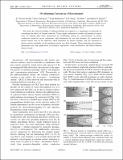| dc.contributor.author | Rubinstein, Isaak | |
| dc.contributor.author | Dydek, E. Victoria | |
| dc.contributor.author | Zaltzman, Boris | |
| dc.contributor.author | Deng, Daosheng | |
| dc.contributor.author | Mani, Ali | |
| dc.contributor.author | Bazant, Martin Z. | |
| dc.date.accessioned | 2012-01-27T19:36:35Z | |
| dc.date.available | 2012-01-27T19:36:35Z | |
| dc.date.issued | 2011-09 | |
| dc.date.submitted | 2011-02 | |
| dc.identifier.issn | 0031-9007 | |
| dc.identifier.issn | 1079-7114 | |
| dc.identifier.uri | http://hdl.handle.net/1721.1/68684 | |
| dc.description.abstract | We revisit the classical problem of diffusion-limited ion transport to a membrane (or electrode) by considering the effects of charged sidewalls. Using simple mathematical models and numerical simulations, we identify three basic mechanisms for overlimiting current in a microchannel: (i) surface conduction carried by excess counterions, which dominates for very thin channels, (ii) convection by electro-osmotic flow on the sidewalls, which dominates for thicker channels, and (iii) transitions to electro-osmotic instability on the membrane end in very thick channels. These intriguing electrokinetic phenomena may find applications in biological separations, water desalination, and electrochemical energy storage. | en_US |
| dc.description.sponsorship | Massachusetts Institute of Technology. Energy Initiative | en_US |
| dc.description.sponsorship | Israel Science Foundation (Grant No. 65/07) | en_US |
| dc.language.iso | en_US | |
| dc.publisher | American Physical Society (APS) | en_US |
| dc.relation.isversionof | http://dx.doi.org/10.1103/PhysRevLett.107.118301 | en_US |
| dc.rights | Article is made available in accordance with the publisher's policy and may be subject to US copyright law. Please refer to the publisher's site for terms of use. | en_US |
| dc.source | APS | en_US |
| dc.title | Overlimiting Current in a Microchannel | en_US |
| dc.type | Article | en_US |
| dc.identifier.citation | Dydek, E. et al. “Overlimiting Current in a Microchannel.” Physical Review Letters 107.11 (2011): n. pag. Web. 27 Jan. 2012. © 2011 American Physical Society | en_US |
| dc.contributor.department | Massachusetts Institute of Technology. Department of Mathematics | en_US |
| dc.contributor.approver | Bazant, Martin Z. | |
| dc.contributor.mitauthor | Dydek, E. Victoria | |
| dc.contributor.mitauthor | Zaltzman, Boris | |
| dc.contributor.mitauthor | Deng, Daosheng | |
| dc.contributor.mitauthor | Mani, Ali | |
| dc.contributor.mitauthor | Bazant, Martin Z. | |
| dc.relation.journal | Physical Review Letters | en_US |
| dc.eprint.version | Final published version | en_US |
| dc.type.uri | http://purl.org/eprint/type/JournalArticle | en_US |
| eprint.status | http://purl.org/eprint/status/PeerReviewed | en_US |
| dspace.orderedauthors | Dydek, E.; Zaltzman, Boris; Rubinstein, Isaak; Deng, D.; Mani, Ali; Bazant, Martin | en |
| dspace.mitauthor.error | true | |
| mit.license | PUBLISHER_POLICY | en_US |
| mit.metadata.status | Complete | |
